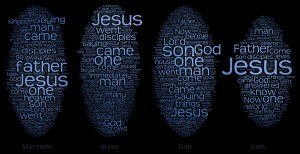Intro To Gospels
Posted on November 5, 2012 by David Holder
Luke begins his Gospel with a remarkable paragraph in which he provides insight into how he produced his work. Luke notes that others had written eyewitness testimony of Jesus’ life and work, and that he had collected and investigated these in order to compose for Theophilus an orderly account of what Jesus had done and said. But Luke was not the only person who wrote such a work. In fact, four Gospels stand at the beginning of our New Testament, introducing Jesus in a multi-dimensional, soul-stirring, and life-changing story. But what are these Gospels?
The first four books of our English New Testament are usually referred to as the Gospels – what we can call written documentaries about Jesus’ life, death, and resurrection. These books are unique in that there are few works like them among documents in the ancient world. The Gospels are selective, purposed, passionate presentations of Jesus’ life, both His works and words, and especially His death and resurrection.
Joel B. Green observes, in his work, How to Read the Gospels and Acts, “In them we read of the most exciting and mysterious happening – God Himself openly declares his solidarity with men and women, indeed with all creation in an unprecedented way. He is Immanuel, God with us. He becomes as we are, lives among us, rejoices and suffers with us. All of this he does with us and for us, for our salvation. In the Gospels the message of redemption appears as no ivory-tower philosophy. Good news is presented as no mere set of ideas, no list of propositions. It breathes; it walks and talks; it is the man, Jesus of Nazareth. Here God intervenes in real, this-worldly history. Here is a marvelous story, full of life and vitality, to which men and women across the centuries have been drawn again and again.”
Each Gospel writer tells Jesus’ story with a certain audience in mind, a certain perspective to offer, and a particular purpose he wishes to accomplish.
The first three Gospels – Matthew, Mark, and Luke – are quite similar in content and structure. At the end of the eighteenth century, the three books were designated by a German scholar as “synoptic,” from a Greek word synopsis meaning “seeing together.” You recognize the word “optic,” signifying seeing and “syn,” a Greek prefix meaning with or together. Matthew, Mark, and Luke “see together” in that all present their accounts of Jesus’ life and work in generally the same geographic sequence and by including roughly the same events.
Only briefly do I refer to what has been termed “the synoptic problem,” that is, the relationship between Matthew, Mark, and Luke. These books have both striking similarities and notable differences. The similarities leave the impression that some interplay occurred between the books. Students and scholars dealing with the synoptic problem hypothesize concerning this interplay. Following is an attempt to diagram the evidence of the Synoptics:
• 76% of Mark is reproduced in Matthew and Luke, comprising 45% of Matthew’s work and 41% of Luke’s work.
• 18% of Mark is found in only Matthew, comprising 10% of Matthew; 3% of Mark is found only in Luke, comprising 1% of Luke.
• Matthew (25%) and Luke (23%) share material not found in Mark, while 20% of Matthew is unique to his Gospel and 35% of Luke is unique.
It seems likely that some connection exists between the Synoptics, though we will never know with any degree of certainty what actually occurred. What is more important and vital is that we appreciate the fact that we have one gospel presented in four Gospels. Each writer had his own style, sources, audience, and purpose. Though it can be helpful in constructing the details of Jesus’ life and work to compare the Gospels, it is more important to let each book stand on its own and speak its message. The practical import of this is that in study these books we may compare accounts and pick up different details and nuances, though it is better to allow each Gospel writer to present his portrait of Jesus. This way we get the best, most accurate, and in the end the most powerful picture of Jesus’ life and work, death and resurrection.
The impact of the Gospels is enormous. These four books are our best, most complete, and most accurate presentations of Jesus of Nazareth – God’s Son and the world’s savior.
The Gospels are historical documents. They present to us historical accounts of Jesus’ life, including places, events, people, and historical settings. All this makes for an authentic picture of Jesus. He was a real person who lived in our world.
The Gospels also as are good news. We certainly don’t want to miss this. The Gospels tell us of Jesus’ birth, life, earthly work, preaching, healing, helping, debating, dying, and being raised. He was a man of power, compassion, authority, determination, love, anger, and purpose. He lived a life in the world without sin. He spoke words that amazed people, like no one had every heard. He did miraculous, stupendous works – healing the sick, giving sight to the blind, making the lame walk, and raising the dead.
The message of these books is cast in story form, but it is not fantasy or fairy tale. Each book comprises a portrait of a man – historical, influential, and compelling. In these four unique books we encounter Jesus, in whom we have faith and through whom we are saved.
PODCAST SUMMARY: Route 66: A Journey Through The Bible – Introducing The Gospels


